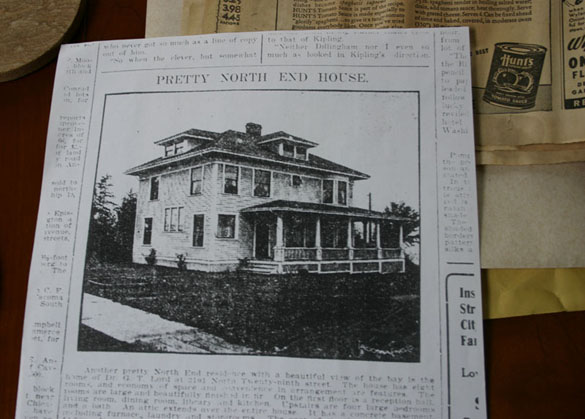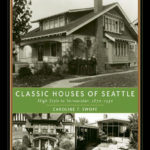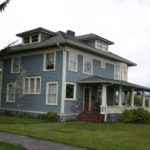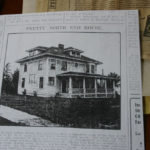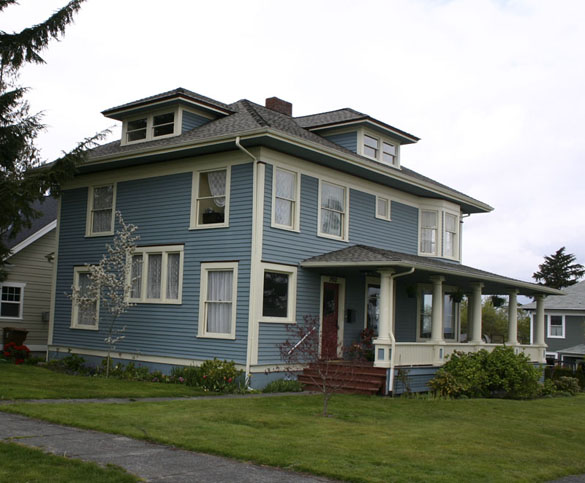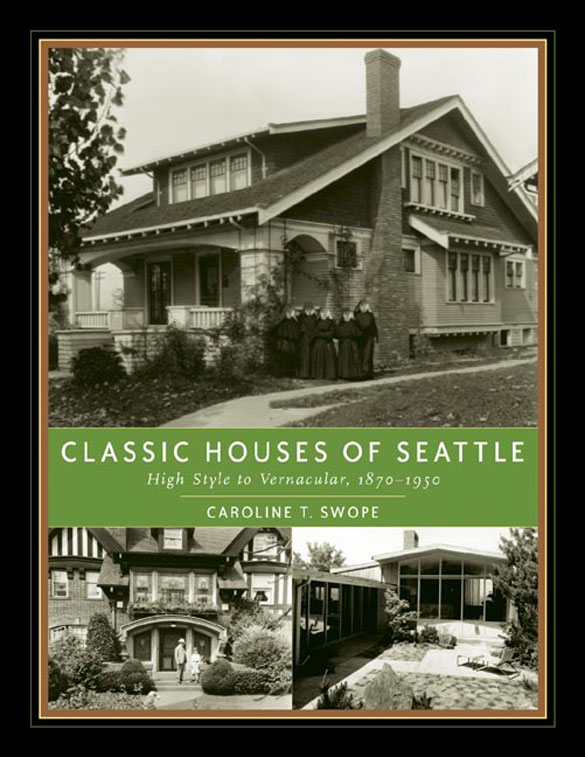When local property owners embark on a process to put their heritage properties on the City of Tacoma’s register of historic places, some choose to go it alone, while others hire professional assistance. One person frequently called upon to provide expertise in completing a nomination application and guiding homeowners through the process is preservationist and design consultant Dr. Caroline T. Swope.
“It is really about this mystery,” says Swope, who holds a masters degree in historic preservation, a doctorate in architectural history, and serves on the city’s landmarks preservation commission and Historic Tacoma’s board of directors. She is also author of Classic Houses of Seattle: High Style to Vernacular, 1870-1950 (Timber Press, 2005). “The mystery is you have this place, and you have to figure out the unknown. Who lived here? What did they do? Who built it? Is this house like other houses in Tacoma? It’s your job to start pulling all these strings that weave into something that hopefully makes sense. At the end of the day, you are documenting local history.”
Swope knows this first-hand.
Last summer, her 100-year-old Colonial Revival home in the city’s North End was added to Tacoma’s historic register (the home is also included on state and national registers).
The story behind her home started to reveal itself when Swope came across a simple, black-and-white photocopy of a photograph published in the Sept. 30, 1906 edition of the Tacoma Daily Ledger. The photograph depicted her two-story home with big windows and a wrap-around porch much in the way it appears today. It was accompanied by a simple headline — “Pretty North End Home.”
It was an understatement.
Swope knew the home she purchased in fall 2005 with her husband, David Waring, was old. But she had little idea it played such an important role in Tacoma history. It was designed by Sherman L. Blair, a prominent contractor who had a hand in the construction and design of some of the most significant heritage buildings in Tacoma — buildings with the names of city fathers like Rowland, Bullard, and Lord attached to them. Between 1910 and 1935, Swope’s home was residence to May Heusten, widow of notable attorney Benjamin Heusten. It was here that May raised her two sons, Emory and Alfred, alone, and laid the groundwork for Tacoma’s Pure Food Laws — a grassroots movement nationwide that led to the formation of the Federal Food and Drug Administration. According to Swope, the boys’ initials are carved in wood and glass throughout the house. During our interview, Swope pointed out three initials — A-L-F — scratched into a window pane in the kitchen. Swope assumes Alfred was in the middle of carving his initials, but was thwarted by his mother.
Swope has handled the nominations of many heritage homes: the Osgood-Anderson House — a large Shingle-Style residence in the Stadium National Historic District — was added to city and state historic registers as a result of her work; she also worked on a nomination of the Johnson Residence — a large Craftsman in Tacoma’s Wedge neighborhood — to the city’s historic register; currently, she’s working on a historic structures report for a ranch in northern California dating back to 1870.
“I’ve been working in historic preservation for about 15 years,” says Swope. “Some [projects] have been as simple as single nominations, others have been surveys of entire downtown commercial districts, or walking tours of entire neighborhoods.”
The Tacoma Daily Index recently met Swope to discuss her experiences and observations related to adding properties to historic registers.
TACOMA DAILY INDEX: How did you initially become interested in historic buildings?
DR. CAROLINE T. SWOPE: It was just one of those things for me. As a kid, I would go to my friends’ houses, play hide and seek, and wander around looking at their houses. I don’t know why that was. It was just this sense of space, and what the space enveloped. I grew up in split-level, 1970s and 1980s homes. Most of my friends and family had houses 100 to 150 years old. I think when you combine that interest in architecture — and my favorite board game was Clue — I was naturally interested in the mysteries and histories of buildings.
INDEX: How many people have you helped in getting their buildings nominated to the City of Tacoma’s historic register?
SWOPE: Last year, I worked on five nominations that went through the process. There were some multiple nominations that went through the city, state, and national nomination process on the same houses: three local, two state, and one national.
INDEX: What’s that initial conversation with property owners like?
SWOPE: The majority of people have houses that need a lot of work, and property owners have heard there’s this tax incentive program [for historic properties]. But the house has to be on the register. People ask, ‘Can you help us figure that out?’ Also, a handful of people have tremendous pride of place and want to make sure their home is protected. The first thing most people tell me is they have done a lot of research on their own, and I won’t need to do a lot of research. It can be a lot of material — several inches of Xeroxes — but not necessarily systematic of what has been researched and why. It may be interesting information, but not in any way documented, which makes it hard to use, but not impossible. It’s just sort of a random assortment of things. It can take longer to sort through that than do the research again.
INDEX: When someone hires you, how long does it take in terms of initial research, completing the nomination application, and finally submitting it for consideration to historic registers?
SWOPE: It really varies. The process depends on what else I have on my plate, and how urgent it is for homeowners. Sometimes I’ll spend a tremendous amount of time on a nomination and get nothing. It’s a challenge because you don’t always know. For some of the big, grand houses where movers and shakers lived 20 to 30 years ago, I can get a lot of information. For some of the smaller houses, it’s a little more challenging to pull the information together. It can be a case where a swank, amazing architect built the home. It can be the best example of a Victorian home in the North End. Or it can be a case of ‘George Washington slept here.’ A strong nomination will cover as many of those things as possible. You don’t get just hung up on the house. You look at the owner, the builder — you look at every aspect of the home.
INDEX: How much does it cost to hire a professional to complete the research and nomination application?
SWOPE: It varies. The City of Tacoma requires 15 copies of paperwork and images related to the nomination. Also, there’s a $100 application fee just to get a property on the register. If you apply to the state and national registers, they are much more particular about the caliber and format of the applications. It becomes more expensive. The larger the building, the bigger the documenting task. I would say it depends on who you hire and what you are asking them to do. I would say that for the average two-story, 2,500-square-foot home, it would cost around $1,500, which isn’t that much when you put it in context that you have to have the nomination to be eligible for special tax valuation. The tax valuation can be worth $40,000 to $50,000 on a remodel. That’s cheaper than hiring a contractor, plumber, or carpenter.
INDEX: What hurdles — real or perceived — are out there for getting a property on the historic register?
SWOPE: I’ve heard them all. Some people say, ‘If I put my house on the register, I’ll have to open it up to the public. It won’t be a private residence anymore.’ That’s not true. There’s a lot of concern about what homeowners can do to the inside of their homes. Unless you have something that has a landmarked interior, or unless you go specifically for an interior nomination, you can handle the interior anyway you would like. Putting a building on the register is essentially a different type of zoning. It applies to the exterior only.
INDEX: Do homeowners have to hire a professional historian to help put their property on the register? Or is it something they can do alone?
SWOPE: There are lots of things you can do by yourself. But you need to ask, ‘What is your time worth? Do you want to follow it through the process?’ It’s like anything else. If you are a Do-It-Yourselfer, you love your home and have a passion for it, by all means go have fun with it.
INDEX: It seems like a Do-It-Yourselfer or someone who takes particular pride in their home or local history would go to the effort and expense of putting their home on a register. Do you think that because it takes a certain type of person to go to the effort that limits the number of properties added to the register?
SWOPE: That’s a good question. I think a lot of people, regardless of whether they have the time or the interest, don’t think their house is significant. They will have what they consider to be a very typical, run-of-the-mill house and couldn’t think in their wildest dreams why their house would be considered significant. There are a fair amount of people that might be interested, but it wouldn’t even cross their mind. A number of people contact me and say, ‘I just have a normal house.’ You don’t understand. The register isn’t about saving all the Vanderbilt homes in Tacoma. It is a project. It’s very much like scrap-booking. Anything that’s valuable is going to take time. But it’s the same thing if you are painting your house. It takes a fair amount of time.
Todd Matthews is editor of the Tacoma Daily Index and recipient of an award for Outstanding Achievement in Media from the Washington State Department of Archaeology and Historic Preservation for his work covering historic preservation in Tacoma and Pierce County. He has earned four awards from the Society of Professional Journalists, including third-place honors for his feature article about the University of Washington’s Innocence Project; first-place honors for his feature article about Seattle’s bike messengers; third-place honors for his feature interview with Prison Legal News founder Paul Wright; and second-place honors for his feature article about whistle-blowers in Washington State. His work has also appeared in All About Jazz, City Arts Tacoma, Earshot Jazz, Homeland Security Today, Jazz Steps, Journal of the San Juans, Lynnwood-Mountlake Terrace Enterprise, Prison Legal News, Rain Taxi, Real Change, Seattle Business Monthly, Seattle magazine, Tablet, Washington CEO, Washington Law & Politics, and Washington Free Press. He is a graduate of the University of Washington and holds a bachelor’s degree in communications. His journalism is collected online at wahmee.com.
